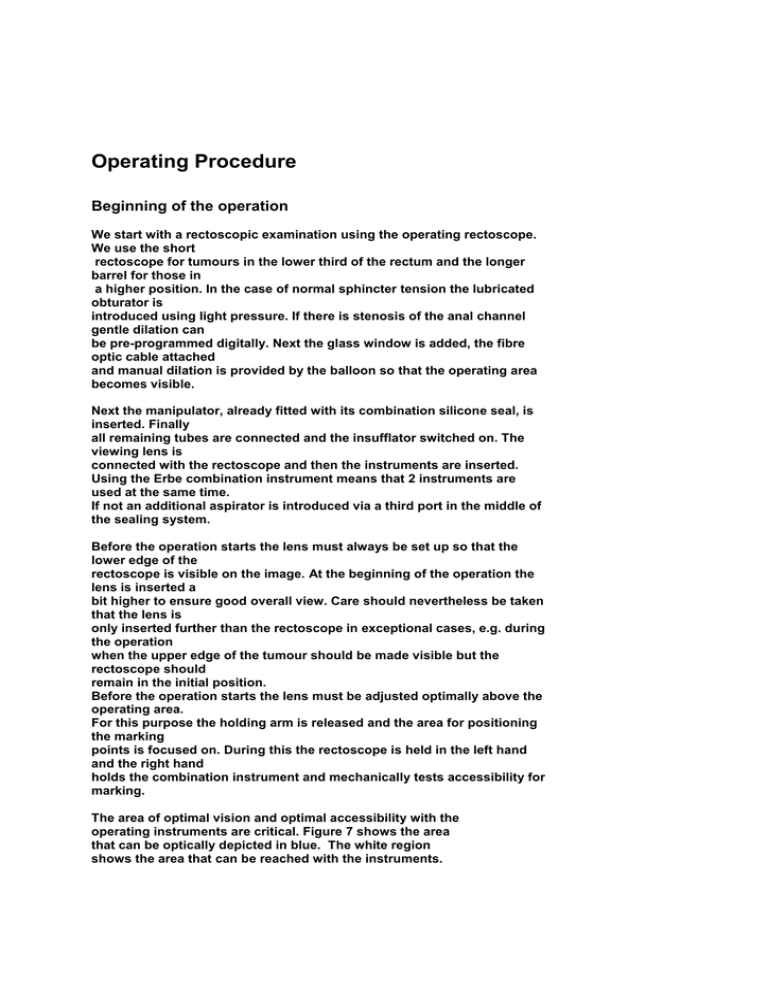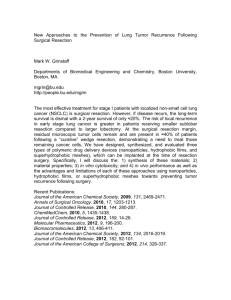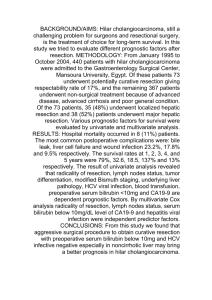Operating Procedure Beginning of the operation
advertisement

Operating Procedure Beginning of the operation We start with a rectoscopic examination using the operating rectoscope. We use the short rectoscope for tumours in the lower third of the rectum and the longer barrel for those in a higher position. In the case of normal sphincter tension the lubricated obturator is introduced using light pressure. If there is stenosis of the anal channel gentle dilation can be pre-programmed digitally. Next the glass window is added, the fibre optic cable attached and manual dilation is provided by the balloon so that the operating area becomes visible. Next the manipulator, already fitted with its combination silicone seal, is inserted. Finally all remaining tubes are connected and the insufflator switched on. The viewing lens is connected with the rectoscope and then the instruments are inserted. Using the Erbe combination instrument means that 2 instruments are used at the same time. If not an additional aspirator is introduced via a third port in the middle of the sealing system. Before the operation starts the lens must always be set up so that the lower edge of the rectoscope is visible on the image. At the beginning of the operation the lens is inserted a bit higher to ensure good overall view. Care should nevertheless be taken that the lens is only inserted further than the rectoscope in exceptional cases, e.g. during the operation when the upper edge of the tumour should be made visible but the rectoscope should remain in the initial position. Before the operation starts the lens must be adjusted optimally above the operating area. For this purpose the holding arm is released and the area for positioning the marking points is focused on. During this the rectoscope is held in the left hand and the right hand holds the combination instrument and mechanically tests accessibility for marking. The area of optimal vision and optimal accessibility with the operating instruments are critical. Figure 7 shows the area that can be optically depicted in blue. The white region shows the area that can be reached with the instruments. Figure 8 shows how much the surgeon will see. The basic rule do adhere to is that the lower half of the image is optimal for surgical tasks, while the upper half of the image should give a good overall picture. Fig. 1 Fig. 2 Establishing safe distances and the resection technique In the case of adenoma a safety perimeter of at least 5 mm is required and with carcinoma a distance of 10 mm should be left. The planned resection route follows the coagulation points that are set out before resection begins (Fig. 9). This means that if a bleeder occurs, even during the procedure, the resection line is still visible, even if the edges of the tumour are not well visible due to the blood. Fig. 3 Most tumours can be found in the extraperitoneal area of the rectum. In this position we always use full-thickness resection. If a carcinoma is in a lateral or posterior position we often remove perirectal fat as far as the pelvic muscles. In order to avoid opening the peritoneum we resect adenomas on the front wall in the upper area of the rectum and in the lower sigmoid using mucosectomy or partial thickness resection. Partial resection removes surface muscle fibres to guarantee a somewhat thicker preparation layer. If the field of operation needs to be adjusted the inexperienced surgeon should Proceed as follows: The holding arm is opened, the rectoscope moved to the optimal viewing position using the left hand and simultaneously mechanical accessibility to the operating area is tested with an instrument held in the right hand. This is the only way to guarantee optimal visual focus and working area from the beginning. The technique of mucosectomy At the beginning of mucosectomy care must be taken that the first incision into the preparation layer is not too deep. It is also important to note that the mucosa tears extraordinarily easy, thus the graspers should only ever hold the edge of the safety border and not pull. If the mucosa tears in the direction of the tumour the pathologist will not longer be able to confirm that it is completely removed. At the beginning of mucosectomy (see figure 10) the mucosa is carefully lifted by the graspers and then cut away using small careful preparation incisions. The incision is made as deep as the silvery muscular layer. These preparation steps should be made under the best possible optical enlargement, thus the lens should be positioned as near to the operating area as possible. During the rest of the preparation the tumour with its safety border is folded up and preparation continued cutting alternatively from left and right. Strong bleeders are seldom during mucosectomy. Nevertheless even the smallest bleeder should be localised and coagulated immediately. To achieve this the blood is aspirated and the bleeder precisely located using scanning movements, then compressed and coagulated using the foot pedal. Fig. 4 In the case of tumours beginning at the linea dentata that are highly likely to be adenomas, the mucosectomy technique for preparation should initiated to avoid the partial severing of the sphincter muscle. This can be replaced with fullthickness resection from 10 mm above the crypten region. Preparation using the Erbe-TEM-Combination instrument offers the following advantages: Less collision with other instruments. Continuously good vision and little smoke due to aspiration on the instrument tip. Faster reaction times as coagulation and aspiration instruments do not have to be inserted separately. Care should be taken that the safety border around the upper edge of the polyp is not made too wide. For this reason the edge of the tumour must always be visible so that the upper safety border can be accurately measured. Complete haemostasis must be carried out at the end of the operation. Partial resection This preparation technique is basically similar to that of mucosectomy. The removal Of a thin layer of muscle accompanies a slightly more solid basis for the operative specimen and, if an early carcinoma is present, a defined safety border. Partial resection can be performed in the vicinity of the sphincter and as well as in higher positions on the front wall, although the muscle layer of the bowel is extraordinarily thin here and extreme caution must be exercised. Full-thickness resection There are two arguments in favour of the full-thickness resection. If a tumour turns out to be a T1 carcinoma (which can never be completely excluded) fullthickness resection guarantees complete removal, with respect to depth. This technique also allows for the removal of larger polyps, without causing tears on the edges, so that the pathologist may successfully confirm the completed resection. At the end of the operation the resected preparation complete with its safety margin is spread out on a corkboard. The technique of full-thickness resection The order of steps for cutting out the polyp. The safety margin is determined by the markers. Start at the lower edge in a clockwise manner. Fig. 5 The needle is retracted in the case of a bleeder. The bleeder is compressed and then coagulated Fig. 6 Preparation of the base using the 5 mm ultrasonic scissors. The tumour-carrying wall is raised with the graspers and the fat with vessels is cut through. This leads to a clear reduction in the occurrence of bleeders and a quicker operation time. Fig. 7 Staunching bleeder in the perirectal fat. The blood is aspirated using a scanning motion and the vessel is made visible. Then compression and coagulation are carried out. Fig. 8 Fig. 9 a: Histology Mucosectomy. b: Full-thickness c: with perirectal fat Fig. 10 Adenoma removed by full-thickness resection. Inadvertent opening of the peritoneal cavity Any resection at the intraperitoneal positioned rectum can lead to an unintentional opening of the peritoneal area, if the level of resection is too deep. If such an opening occurs, CO2 is lost in the abdominal cavity and vision of the operating field is impeded. The defect should be closed as quickly as possible. The procedure to be followed for this is shown in figure 13a, b. Silver clips will be placed in the rectal lumen and the preparation can continue under correct gas dilation. a Fig. 11 In difficult situations in which suturing in the peritonium causes spatial problems for the continuing preparation, it is possible to carry out a dilated fullthickness resection in the peritonium, complete the resection and then at the end close the whole defect in a single layer. Nowadays we favour this procedure in must cases. It is possible to carry out the resection of a full-thickness segment in the middle third of the rectum with out problems. This is also possible in the lower third of the rectum although suturing on the front wall is impeded. In the case of tumours in a higher position the intraperitoneal front wall section should be resected using the mucosectomy technique, in order to avoid a wide opening of the peritoneum. By tipping up the rectoscope to an extreme angle the area at the front wall of the middle rectum is well depicted so that suturing is possible. Suturing technique Uncomplicated suturing In general we use 3x0 moncry with a SH needle for suturing. The suture is prepared with the thread shortened to 80 mm so that the silver clip can be pressed on to the end. 5mm of thread should be left behind the clip. Before inserting the needle the seal lid on the needle holder should be adjusted so that the needle doesn’ thavet o be pulled through the seal lid. The tip of the needle should be pointing slightly backwards so that during insertion the finger-like silicone seal is not destroyed. Position of the needle Fig. 12 Automatic setting. Special form of the needle holder Suturing should always be carried out diagonally. In the case of large defects we therefore recommend a positioning suture in the middle of the defect so that the relation between the upper and lower wall sections is obvious. After this the first suture is placed on the right hand edge of the wound towards the middle (figure 14a). The stitches proceed from lumen to extraluminal and then back again into the lumen. On the right side of the defect the wall closest to the anus (from the surgeons perspective) is always sutured first, from intraluminal to extaluminal and then again in the upper area back into the lumen. High tension can be neutralised by replacing all 2 or 3 sutures (figure 14b) with intermediary clips. Fig. 1 To close a semi-circular defect approx. 4 threads are normally used. When the left edge of the wound is reached the back wall is normally shortened so that the front wall hangs down like a curtain. To judge the width of anastomosis the front wall should be held up slightly by two instruments. It is important to note that the suturing must also cover the end point of the wound, this can be hidden by a fold-formation. In the case of very large defects several positioning sutures must be made (see figures 20a and b). Fig. 2 Suturing towards the front wall Fig. 15 The suture is drawn into the visible area with the forceps




